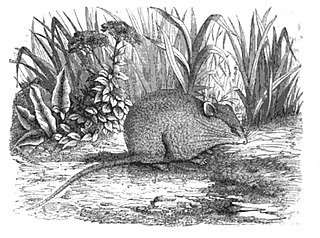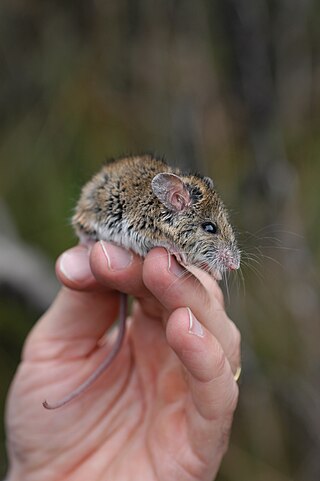
Gould's mouse, also known as the Shark Bay mouse and djoongari in the Pintupi and Luritja languages, is a species of rodent in the murid family. Once ranging throughout Australia from Western Australia to New South Wales, its range has since been reduced to five islands off the coast of Western Australia.

Pseudomys is a genus of rodent that contains a wide variety of mice native to Australia and New Guinea. They are among the few terrestrial placental mammals that colonised Australia without human intervention.

The plains rat(Pseudomys australis), also known as the palyoora, plains mouse and eastern mouse, is a conilurine rodent native to arid and semi-arid Australia. Referred to as the pallyoora or yarlie by Indigenous groups, the plains rat was once widely distributed across central Australia, including north-west New South Wales and south-west Queensland; however, habitat degradation due to grazing, introduced predators and drought have contributed to its decline. Consequently, the plains rat has been listed as 'presumed extinct' in New South Wales and Victoria, 'endangered' in the Northern Territory and Queensland and 'vulnerable' in Western Australia and South Australia. While recent research has indicated the presence of the plains rat in areas such as the Fowlers Gap and Strzelecki Desert regions of New South Wales and within the Diamantina National Park in Queensland, there are only five sub-populations currently recognised nationally, none of which coincide with recent discoveries of the plains rat. As the current population trend of the plains rat has been listed as 'declining' by the International Union for the Conservation of Nature (IUCN), the IUCN conservation status for the species is 'vulnerable'.
The Forrest's mouse, or desert short-tailed mouse, is a small species of rodent in the family Muridae. It is a widespread but sparsely distributed species found across arid and semi-arid inland Australia, commonly found in tussock grassland, chenopod shrubland, and mulga or savannah woodlands.

The ash-grey mouse is a rodent in the family Muridae. Larger and more robust than Mus musculus, the common house mouse, it is found only in Southwest Australia.
The silky mouse is a species of rodent in the family Muridae. It is found only in Australia.
Western pebble-mound mouse or Ngadji is a burrowing and mound building rodent in the family Muridae. They occur in the Pilbara, a remote region in the northwest of Australia.

The little native mouse, also known as the delicate mouse, is a species of rodent in the family Muridae. The Kunwinjku people of western Arnhem Land call this little creature kijbuk.

The desert mouse, also known as the brown desert mouse, is a species of rodent in the family Muridae. It is endemic to Australia. The first desert mouse specimen was collected by Australian zoologist Gerard Krefft on the Blandowski Expedition in 1856-57, between Gol Gol Creek and the Darling River.

The eastern chestnut mouse is a species of rodent in the family Muridae. It is found only in Australia, along the eastern coast from northern Queensland and into New South Wales as far as Jervis Bay.

The sandy inland mouse is a species of rodent in the family Muridae. Also known as the Hermannsburg (Mission) false-mouse or Hermannsburg mouse, it is endemic to Australia and found widely yet sparsely through arid and semi-arid areas.

The New Holland mouse also known as a Pookila is a species of rodent in the family Muridae. It was first described by George Waterhouse in 1843. It vanished from view for over a century before its rediscovery in Ku-ring-gai Chase National Park north of Sydney in 1967. It is found only in south east Australia, within the states of New South Wales, Queensland, Victoria, and Tasmania.

The western mouse or walyadji is a species of rodent in the family Muridae. Once widespread across a larger range, it has become restricted to around ten reserves of remnant bushland in Southwest Australia and declared near threatened by extinction. They are small and robust mice that live in burrows in sandy soil, venturing out at night to forage in nearby area.

The Hastings River mouse is a species of Australian rodent in the subfamily Murinae of the family Muridae. It is found only in Australia.
The Kakadu pebble-mound mouse is a rodent native to Australia. It is one of the pebble-mound mice.
The central pebble-mound mouse is a species of rodent in the family Muridae, native to Australia. The Kimberley mouse was, until recently, considered distinct from P. johnsoni, but they are now known to be conspecific. It is one of the pebble-mound mice.
Pebble-mound mice are a group of rodents from Australia in the genus Pseudomys. They are small, brownish mice with medium to long, often pinkish brown tails. Unlike some other species of Pseudomys, they construct mounds of pebbles around their burrows, which play an important role in their social life.

Triodia basedowii, commonly known as lobed spinifex, is a species of tussock-forming grass-like plant found in Australia.

Hydromyini is a very large, diverse tribe of muroid rodents in the subfamily Murinae. They are the dominant native rodents in Australasia and one of only two native rodent groups there, the other being the R. fuscipes group of the genus Rattus in the tribe Rattini. They are also found in parts of Southeast Asia.












